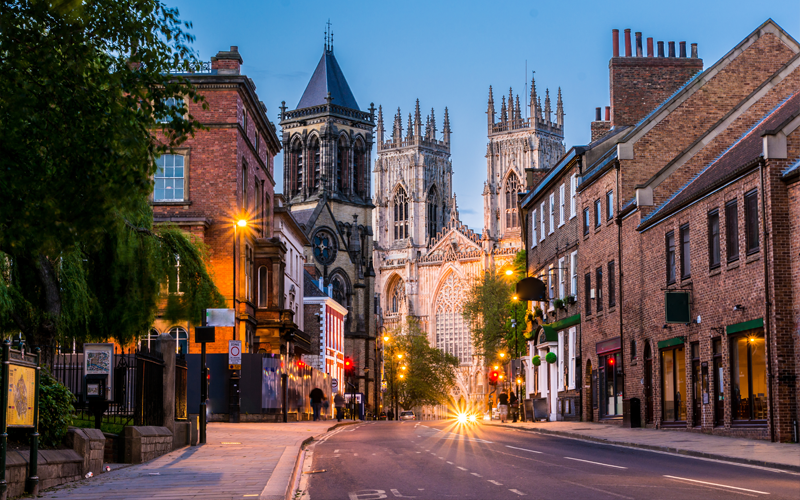As we left Aldeburgh and continued toward the town where the next day we’d be meeting friends, we began seeing highway signs saying, “The North.” It reminded us of the doomsday references in Game of Thrones.
In the U.S., the only time you’d refer to “the North” is if you’re in the deep South, and you’d be referring to history and culture more than geography. If you’re in Texas, where we live most of the time, or in any other part of the country, the north is a great big area. Head to Seattle, or Milwaukee, or Chicago, or New York, or Boston – or many parts on a lower latitude – and you’ll be going north. The contrast made us laugh, but of course Britain is not a huge area, and once you pass above the Midlands – that cummerbund that bisects England from West to East – you are in The North.
York
We spent that night and the next morning in York, which is a beautifully preserved medieval city with a gorgeous cathedral and a largely intact wall and city gates. When we checked into our hotel, I thought the clerk might be Dutch, as we struggled to understand each other. After chatting to people in the lobby, I quickly realized this was the famous Yorkshire accent!
Despite its historical significance, York is at the forefront of the new economy. Its university is renowned for producing graduates with cutting edge digital skills. This small city is frequently mentioned as the most desirable place to live in England today.
Whitby
Later that day we turned east, back toward the North Sea, to the town of Whitby. There we spent the afternoon with Karl Mays and his family. We’d never met, but Karl has been my website consultant for about a decade, and he greeted me with a warm hug. It was lovely to finally meet his wife, Samantha, and their children. They are remarkable people in many ways.
Karl chose Whitby because it’s a place his children love to visit. On that Thursday summer afternoon, the town was packed with people enjoying the video game arcade (the kids), the many shops, the long wharf extending out to the sea, and a variety of restaurants. We settled on one with great fish and chips.
The town is bisected by the River Esk where it flows into the sea. On the East Cliff above town is an old abbey said to have been the inspiration for Bram Stoker’s “Dracula.” There’s a museum dedicated to Captain Cook, and vessels from fishing boats to tourist cruisers. To the left of the wharf is West Cliff beach.

Berwick-Upon-Tweed
As we left to continue our journey, Karl suggested we stop in Berwick-Upon-Tweed. Berwick (pronounced “Berick”) is the northernmost town in England, situated where the River Tweed flows into the North Sea. The ruins of an Elizabethan castle can be seen from town, and its walls remain. The town’s history was chaotic and frequently violent.
During conflicts along the Scottish border, Berwick was passed back and forth between England and Scotland. Even before the countries that comprise Britain developed national identities, Berwick bore the brunt of Roman and Viking invasions.
Today Berwick is a charming beach town, filled with tourists in summer. We arrived just as dark was falling, and we soon realized to our dismay there were no hotel rooms to be had anywhere in the city. After I went to inquire at the last hotel leaving the small downtown, and was given a regretful “no,” I went back to the car. Dempsey and I said a little prayer for direction. It was pitch dark by then, and we were very tired.
Suddenly there was a rap on my window. I rolled it down, and a man who had evidently overheard my conversation at the hotel reception desk showed us his phone. “Here’s where to go,” he said, indicating the Cross Hotel in Kelso, right across the Scottish border. We thanked him profusely and, once more, headed north.



0 Comments